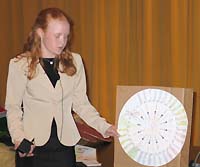MRLS Mini-Conference Spotlights Young Problem-Solvers
MRLS Mini-Conference Spotlights Young Problem-Solvers

When Danielle Mink’s biology students at Tates Creek High School in Lexington dissected an eastern tent caterpillar, they got more than an inside look at the insect associated with Mare Reproductive Loss Syndrome. They got to see real-life science helping solve a real-life problem.
Those students, along with others from West Jessamine High School in Nicholasville and Winburn Middle School in Lexington, were part of a unique research project that partnered them with scientists who study MRLS at the University of Kentucky’s College of Agriculture. The young researchers presented their work at UK May 12.
“We really do consider this project to be a giant step for the way we think about teaching and learning in science class,” said Linda France, deputy commissioner of the Kentucky Department of Education, who was on hand for the presentation.
MRLS, the devastating equine disease that caused thousands of mares to abort their fetuses in the spring of 2001, was the focus of the research project, but basic science learning was the goal, said Carol Hanley, Extension specialist for 4-H youth development and director of environmental education and communications at the Tracy Farmer Center for the Environment.
“They had the opportunity to learn real science out in the field with real scientists,” Hanley said.
Among those scientists was UK entomologist Bruce Webb, whose lab has been studying the eastern tent caterpillar’s role in MRLS. He worked with Hanley and the Fayette County Public Schools’ David Taylor in developing the student project and secured funding for it through a U.S. Department of Agriculture grant. Others involved from UK included Blake Newton, Walter Barney, Esther Fleming and Ashley Osborne.
It was the students’ involvement, however, that was lauded during the presentation. Their “creativity, depth of understanding, and knowledge” was exciting, France said.
The students reported on several aspects of the project, including the life cycle of the eastern tent caterpillar, the effects of MRLS in the community, counting eastern tent caterpillar egg masses and population modeling. Winburn’s Lilian Rogers, 14, presented a video on the scientific writing process.
“I didn’t really like science, and I wasn’t really excited about MRLS,” said Rogers, who admits to never having been around a horse before this project. “So I thought it was really neat that I could intertwine something I did like, writing, and still be interested. Writing helped me warm up to it. I’m glad I got the opportunity to do it.”
Because of the project’s success, UK’s Hanley said she is already talking to school officials in Bourbon and Harrison counties about conducting a similar project on lady beetles, and she would like to see a project on gypsy moths in the eastern part of the state.
“It’s been suggested that all of our students have at least one opportunity to do a real science project out in the community,” she said. “We’re on board to make that happen.”
France agreed, adding that the MRLS project marks the beginning of many more projects like this across the state.
“You don’t have to look far for environmental impact problems that really could engage students in meaningful research in their own communities,” she said. “I think that kind of learning experience engages students’ minds and it opens doors for them that are not open if they stay inside classrooms.”
